Summer Evening Cardigan |
||||||||||||||||||||||
 |
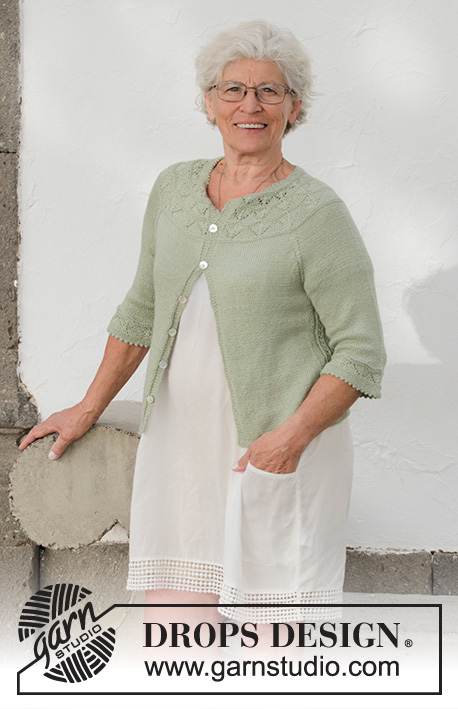 |
|||||||||||||||||||||
Knitted jacket with round yoke, lace pattern and ¾-length sleeves, worked top down. Sizes S - XXXL. The piece is worked in DROPS BabyAlpaca Silk.
DROPS 191-23 |
||||||||||||||||||||||
|
INFORMATION FOR THE PATTERN: RIDGE/GARTER STITCH (worked back and forth): 1 ridge = Knit 2 rows. INCREASE TIP-1 (evenly spaced): To work out how to increase evenly, count the total number of stitches on the needle (e.g. 126 stitches), minus the bands (e.g. 10 stitches) and divide the remaining 116 stitches by the number of increases to be made (e.g. 29) = 4. In this example, increase by making 1 yarn over after every 4th stitch. On the next row/round work the yarn overs twisted to avoid holes. NOTE Do not increase over the bands. PATTERN: See diagrams A.1 to A.4. Choose diagram for your size (applies to A.1). The diagrams show all the rows in the pattern seen from the right side. RAGLAN: All increases are made from the right side! Increase to raglan on each side of the 4 marker threads in each transition between body and sleeves as follows: Start 1 stitch before the marker thread, make 1 yarn over, knit 2 (the marker thread sits in the middle of these 2 stitches), make 1 yarn over (= 2 stitches increased). On the next row purl the yarn overs to leave holes. INCREASE TIP-2 (for sides of body): All increases are made from the right side! Start 6 stitches before the marker thread in the side, make 1 yarn over, knit 2, continue with A.3 (marker thread sits in the middle of A.3), knit 2 and make 1 yarn over (= 2 stitches increased). On the next row (wrong side) purl the yarn overs twisted to avoid holes. DECREASE TIP (for mid under sleeve): Start 2 stitches before A.3, knit 2 together, knit A.3 (= 8 stitches), slip 1 stitch as if to knit, knit 1, pass the slipped stitch over the knitted stitch (= 2 stitches decreased). BUTTONHOLES: Work buttonholes on the left band (when the garment is worn). Work from the right side; knit 1, knit 2 together 1 yarn over and knit to end of row. On the next row (wrong side) knit the yarn over to leave a hole. The first buttonhole is worked on the first row from the right side after the neck. Then work the other 6-6-6-7-7-7 buttonholes with approx. 7-7½-8-7-7-7½ cm between each. ---------------------------------------------------------- JACKET: The yoke and body are worked back and forth on circular needle from mid front and top down. The sleeves are worked in the round with short circular needle/double pointed needles, top down. NECK: Cast on 126-130-134-142-146-154 stitches (including 5 band stitches in each side towards mid front) with circular needle size 3 mm and BabyAlpaca Silk. Change to circular needle size 2.5 mm and work 6 rows stocking stitch for the lining, with 5 band stitches in GARTER STITCH in each side towards mid front – see description of GARTER STITCH above. Then work the next row as follows from the right side: 5 band stitches in garter stitch, * knit 2 together, make 1 yarn over *, work from *-* until there are 5 stitches left on the row and finish with 5 band stitches in garter stitch. You have now worked the folding edge. Work 7 rows stocking stitch with 5 band stitches in garter stitch in each side and increase AT THE SAME TIME 29-33-37-29-33-33 stitches evenly on the last row – read INCREASE TIP-1 = 155-163-171-171-179-187 stitches. Then work the yoke as described below. YOKE: Change to circular needle size 3 mm. The next row is worked as follows from the right side: Work 5 band stitches in garter stitch and work BUTTONHOLES on the band – see description above, work A.1A until there are 6 stitches left on the row (= 18-19-20-20-21-22 repeats of 8 stitches), work A.1B (= 1 stitch) and finish with 5 band stitches in garter stitch. Continue the pattern like this and increase as shown in A.1A. REMEMBER THE KNITTING TENSION! When A.1 has been completed, there are 227-239-251-291-305-319 stitches on the needle and the piece measures approx. 15-15-15-17-17-17 cm from the folding edge on the neck. Knit 1 row from the right side where you increase 23-27-31-23-33-31 stitches evenly on row = 250-266-282-314-338-350 stitches. Now insert 4 marker threads in the piece without working the stitches: The first marker thread is inserted after the first 41-43-45-51-56-60 stitches (i.e. after the front piece), 2nd marker thread after the next 48-52-56-60-62-60 stitches (= sleeve), 3rd marker thread after the next 72-76-80-92-102-110 stitches (= back piece) and 4th marker thread after the next 48-52-56-60-62-60 stitches (= sleeve). There are 41-43-45-51-56-60 stitches left after the last marker thread on the front piece. Continue back and forth with stocking stitch and 5 band stitches in garter stitch in each side towards mid front. AT THE SAME TIME on the first row from the right side increase to RAGLAN – see description above (= 8 stitches increased). Continue to increase to raglan every 2nd row (i.e. every row from the right side) until you have increased a total of 10-13-15-15-16-18 times on each side of the 4 marker threads = 330-370-402-434-466-494 stitches. Continue working as before without increasing to raglan, but to avoid breaking the line of holes on the raglan line, work A.2 (= 6 stitches) in each transition between body and sleeves (the marker threads sit in the middle of A.2). When the piece measures 22-24-26-28-30-32 cm, work the next row as follows from the right side: Work the first 51-56-60-66-72-78 stitches in garter stitch and stocking stitch as before (= front piece), place the next 68-78-86-90-94-96 stitches on a thread for sleeve, cast on 8-8-10-10-12-14 new stitches on the needle (= in side under sleeve), work 92-102-110-122-134-146 stitches stocking stitch (= back piece), place the next 68-78-86-90-94-96 stitches on a thread for sleeve, cast on 8-8-10-10-12-14 new stitches on the needle (= in side under sleeve) and work the last 51-56-60-66-72-78 stitches (= front piece). Body and sleeves are finished separately. THE PIECE IS NOW MEASURED FROM HERE! BODY: = 210-230-250-274-302-330 stitches. Insert 1 marker thread in the middle of the 8-8-10-10-12-14 stitches cast on under the sleeve in each side. Continue with stocking stitch and 5 band stitches in garter stitch in each side towards mid front; in addition work A.3 over the middle 8 stitches in each side (marker threads sit in the middle of A.3). Remember buttonholes on left band. When the piece measures 5-5-5-3-3-3 cm from the separation, increase 1 stitch on each side of A.3 in each side – read INCREASE TIP-2 (= 4 stitches increased). Increase like this every 5 cm a total of 5-5-5-6-6-6 times in each side = 230-250-270-298-326-354 stitches. When the piece measures 31 cm from the separation, work 3 ridges back and forth over all stitches. Then cast off with knit from the right side, but to avoid the cast-off edge being tight, you can make 1 yarn over after every 8th stitch at the same time as you cast off (the yarn overs are cast off as normal stitches). The jacket measures approx. 54-56-58-60-62-64 cm from the shoulder down. SLEEVE: Place the 68-78-86-90-94-96 stitches from the thread on the one side of the piece on double pointed needles or short circular needle size 3 mm and in addition knit up 1 stitch in each of the 8-8-10-10-12-14 stitches cast on under the sleeve = 76-86-96-100-106-110 stitches. Insert 1 marker thread in the middle of the 8-8-10-10-12-14 stitches under the sleeve. Work A.3 over the middle 8 stitches under the sleeve; the remaining stitches are worked in stocking stitch. When the piece measures 2-2-2-1-1-1 cm from the separation, decrease 1 stitch on each side of A.3 – read DECREASE TIP. Decrease like this a total of 8-11-15-16-17-17 times in Size S: Every 6th round, in Size M: Every 4th round, in Size L: Alternately every 2nd and 3rd round and in Sizes XL + XXL + XXXL: Every 2nd round = 60-64-66-68-72-76 stitches. Continue working in the round until the piece measures approx. 17-16-14-12-11-11 cm from the separation, but adjust so that the decreases under the sleeve are finished (NOTE: shorter measurements in the larger sizes due to wider neck and longer yoke). On the next round increase 10-6-4-12-8-4 stitches evenly on round = 70-70-70-80-80-80 stitches. Then work A.4 in the round (= 7-7-7-8-8-8 repeats of 10 stitches). When A.4 has been completed there are 84-84-84-96-96-96 stitches on the needle. Work 6 rounds of stocking stitch. The next round is worked as follows: * Knit 2 together, make 1 yarn over *, work from *-* to end of round (= folding edge). Work 6 rounds of stocking stitch and cast off, but to avoid the cast-off edge being tight, you can make 1 yarn over after every 6th stitch at the same time as you cast off (the yarn overs are cast off as normal stitches). Work the other sleeve in the same way. ASSEMBLY: Fold the lining in the neck towards the wrong side and fasten neatly with small, loose stitches. Do the same around the bottom of both sleeves. Sew on the buttons. |
||||||||||||||||||||||
Diagram explanations |
||||||||||||||||||||||
|
||||||||||||||||||||||
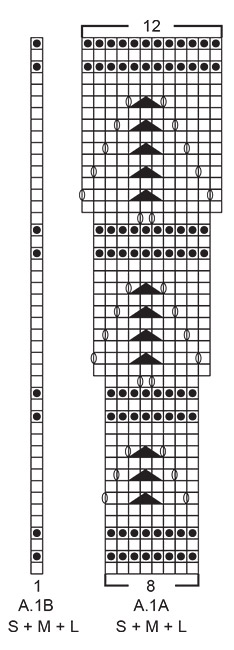
|
||||||||||||||||||||||

|
||||||||||||||||||||||
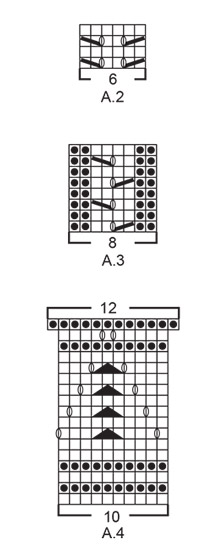
|
||||||||||||||||||||||

|
||||||||||||||||||||||
|
Have you made this or any other of our designs? Tag your pictures in social media with #dropsdesign so we can see them! Do you need help with this pattern?You'll find tutorial videos, a Comments/Questions area and more by visiting the pattern on garnstudio.com. © 1982-2024 DROPS Design A/S. We reserve all rights. This document, including all its sub-sections, has copyrights. Read more about what you can do with our patterns at the bottom of each pattern on our site. |
||||||||||||||||||||||










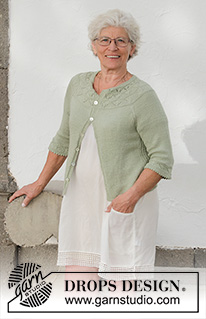

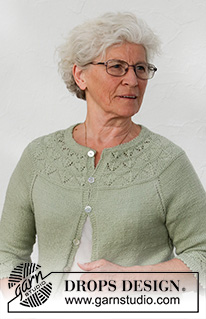

















































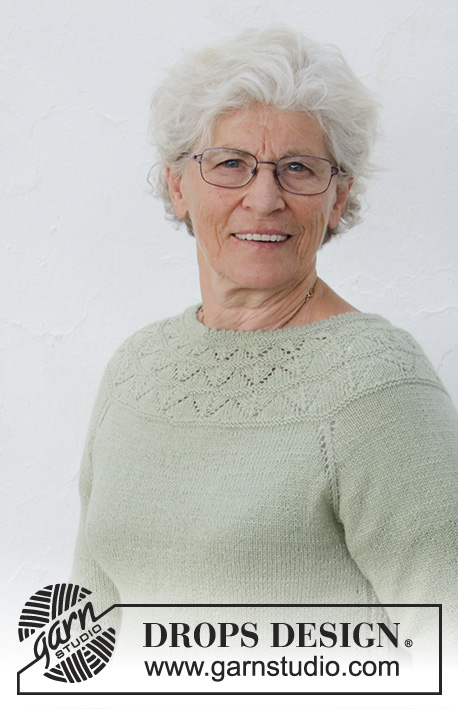








Comments / Questions (23)
Please ignore my previous question as I missed printing the relevant part of the pattern.
20.02.2020 - 21:56I have completed A1A for the third size so 20 x 14 +1 (A1b) and 10 border sts which make 291 but th pattern says I should have 251. Please can you help. To get 251 I would only have 12 sts and not 14 as indicated
20.02.2020 - 21:23DROPS Design answered:
Dear Mrs Elias, in third size = size L, you follow diagram A.1A/A.1B for size S+M+L, ie when A.1A is done there are 12 stitches on each A.1A, so that you have 5 front band sts + 20 x 12 sts + 1 st + 5 front band sts = 251 sts. Happy knitting!
21.02.2020 - 08:01Sehr geehrte Damen und Herren, ich suche die Anleitung für den weißen Rock, den das Model trägt. Können Sie mir sagen, unter welcher Nummer ich die Anleitung finden kann? Mit freundlichen Grüßen Heike Wiedemann
14.07.2019 - 12:26DROPS Design answered:
Liebe Frau Wiedemann, dieser Rock ist keinen gestrickten Rock, hier finden Sie aber alle unsere gestrickten bzw gehäkelten Röcke. Viel Spaß beim stricken!
15.07.2019 - 10:13I'm casting on for this sweater right now. l love it.
09.04.2019 - 15:04Lässt sich dieses Modell auch mit Cotton Merino stricken? Ich brauchedie Anleitung für Größe S und komme mit dem Garnumrechner icht zurecht.
14.10.2018 - 17:57DROPS Design answered:
Liebe Frau Pfeiffer, diese Jacke wird mit DROPS BabyAlpaca silk gestrickt, dh ein Garn der Garngruppe A - DROPS Cotton Merino gehört zur Garngruppe B. Hier lesen Sie mehr über Garnalternativen. Viel Spaß beim stricken!
15.10.2018 - 10:34Hallo, wenn ich die Jacke nach Anleitung arbeite und das erste Knopfloch auf der Hinreihe stricke sind die Knopflöcher doch seitenverkehrt, oder? Eigentlich müssten sie doch am Ende der Hinreihe oder am Anfang der Rückreihe gestrickt werden,oder. danke
21.09.2018 - 10:20DROPS Design answered:
Liebe Frau Stahlman, in diesem Modell werden die Knopflöcher auf der linken Blende gestrickt. Wenn Sie sie auf der rechten Blende, dann sollen Sie sie am Ende einer Hinreihe stricken. Viel Spaß beim stricken!
21.09.2018 - 11:41Wozu braucht man nach 6 Reihen noch 7 Reihen im Musterbild sehe ich diese nicht
13.09.2018 - 20:25DROPS Design answered:
Liebe Dana, diese 7 Reihen am Hals braucht man für die gefaltete Kante mit Picotrand: die ersten 6 Reihen werden innen genäht und die letzten 7 Reihen werden die Kante bilden (Picotrand erhält man mit den Löcherrand). Viel Spaß beim stricken!
14.09.2018 - 08:19Amy wrote:
The pattern says, “ slip 1 stitch as if to knit, knit 2 together, pass the slipped stitch over the knitted together stitches,” for the double decreases in the yoke. According to The Knitter’s Book of Finishing Techniques, this is the Double Central Decrease. The photo with the pattern (though blurry) looks more like the Central Chain Decrease. I have started with the decreases as written, and they seem lumpy and do not show the line down the the yoke as in the pattern photo. What to do?
20.08.2018 - 18:41DROPS Design answered:
Dear Amy, If you want a line to show, then, do the Central Double Decrease. It is another way to do a doubel decrease and it will be a centered decrease. Thank you for your input and suggestion! Happy Knitting,
30.08.2018 - 12:06Amy wrote:
Are the increase rows in the yoke meant to be worked through the back loop so they will be closed, or worked open so they are part of the lace pattern? Thank you!
20.08.2018 - 18:17DROPS Design answered:
Hi Amy, The increases on the yoke are worked to open for the lace pattern. Happy knitting!
20.08.2018 - 19:08Bonjour, pour les augmentations (diagramme A.1A) faut-il seulement augmenter d'une maille à chaque début ou fin de rang ou doit-on faire les augmentations tout le long du rang à intervalles réguliers ? Merci pour votre aide
03.06.2018 - 19:38DROPS Design answered:
Bonsoir Valerie! Les augmentations sont inclues dans le diagramme A.1A. Dans les 3 premieres tailles (S, M, L), vous augmentez 2 mailles (grace a 2 jetes) a chaque repetition du diagramme aux rangs: 17 et 31. Dans les tailles XL, XL et XXXL, vous augmentez 2 mailles a chaque repetition du diagramme aux rangs: 5, 19 et 35. Bon tricot!
03.06.2018 - 23:04